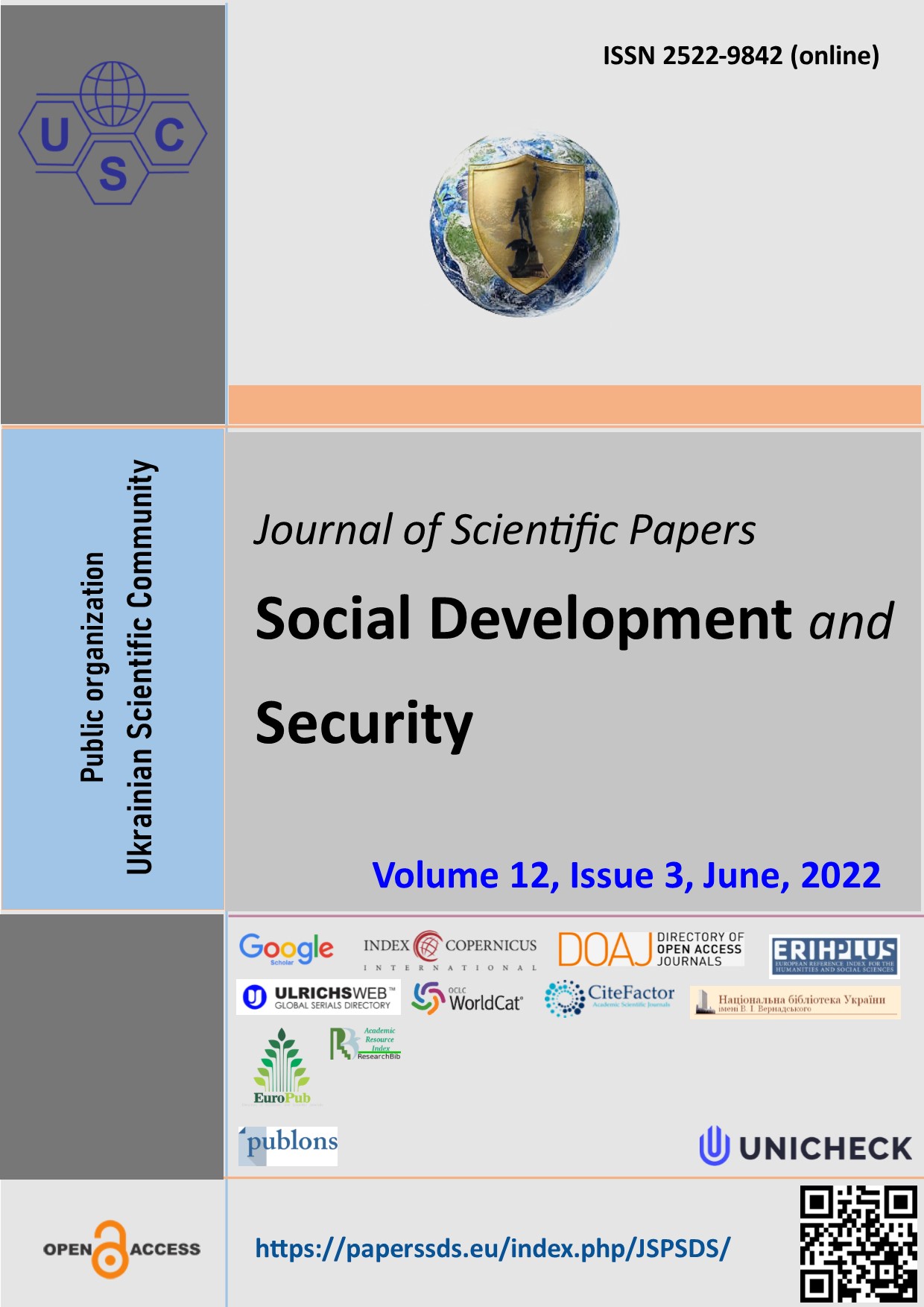Mathematical model of failure of control points of perspective automated control system of troops and their restoration
Abstract
Purpose: development of a mathematical model of failure of control points and their restoration to substantiate the requirements for the survivability of a promising automated control system of troops.
Design/Method/Approach: the main research methods are the methods of the theory of Markov processes, the theory of graphs.
Findings: developed a mathematical model of failure of control points and their restoration of a promising automated control system for troops.
Theoretical implications: the developed mathematical model allows, in contrast to existing models, to determine in time the state of the control system under the influence of the enemy and the restoration of its control points of the forces and means of our troops.
Paper type: descriptive.
Downloads
References
About the Military Security Strategy of Ukraine: Decree of the President of Ukraine dated March 25, 2021. Available from : https://www.president.gov.ua/documents/1212021-37661
About the Strategic Defense Bulletin of Ukraine: Decree of the President of Ukraine dated September 17, 2021 No. 473/2021. Available from : https://zakon.rada.gov.ua/laws/show/n0063525-21#Text
The concept of departmental programs for the creation of a Unified automated management system of the Armed Forces of Ukraine, a single information system for the management of defense resources and information infrastructure until 2020: approved. Minister of Defense of Ukraine on May 12, 2018. Кyiv. 2018. 13 с.
Shuenkin V.O. (2010). On the evaluation of the effectiveness of the command and control system of troops (forces). Science and Defense. № 4. P. 23–28.
Len V.L., Malyshev V.A. (2020). Method of building models of the conflict of the opposing parties to assess the efficiency of decision-making on combat operations in the control system of troops. Air and Space Forces. № 15. S. 10–16.
Romanchenko I. S., Shenkin V. O., Svyda I. Y., Khomchak R. B. Development of the theory of contributions of military formations from the composition of the created group of troops to ensure their combat effectiveness during hostilities: a monograph. Kyiv: Central Research Institute of the Armed Forces of Ukraine, 2020. 288 p.
Anfilatov V.S., Emelyanov А.А. System analysis in management. Moscow: Finance and Statistics, 2003. 368 p.
Tarakanov K. V., Ovcharov L.A., Tyryshkin A.N. Analytical methods of systems research. Moscow: Sov. radio, 1974. 240 p.
Management theory in military systems / A.V. Bogovik, S.S. Zagorulko, I.S. Kovalev, I.V. Kotenko, O.V. Masanovets; under ed. I.V. Kotenko. Moscow: Ministry of Defense, 2001. 320 p.
Tkachenko V.I., Smirnov E.B. and others. Theory of decision-making by military authorities: monograph. Kharkiv: HUPS, 2008. 545 p.
Tkachuk P.P., Budaretsky Y.I., Shchavinsky Y.V., Prokopenko V.V. (2015). Influence of means of automation of control of divisions and artillery fire on efficiency of its application. Military-technical collection. № 12. S. 75–82.
Kirsanov S.O., Ostrovsky S.M. (2018). Methodical approach to assessing the level of automation of government. Modern information technology in the field of security and defense. № 3 (33). Pp. 77–80.
Fundamentals of the theory of command and control / ed. P.K. Altukhov. Moscow: Voenizdat. 1984. 221 p.
Military encyclopedic dictionary. Moscow: Voenizdat, 1986. S. 256.
Ventzel E.S. Research of operations. Moscow: Soviet Radio, 1972. 552 p.
Shuenkin V.A., Donchenko V.S. Applied models of queuing theory: uch. pos. Kyiv: NMK VO, 1992. 398 p.
Gnedenko B.V., Kovalenko I.N. Introduction to the theory of queuing. Moscow: Nauka, 1966. 432 p.
Toropchin A. Ya. Handbook of air defense / A. Ya. Toropchin, I.O. Romanenko, Yu. G. Danyk, R.E. Pashchenko and others. Кyiv: МО України, Kharkiv: ХВУ, 2003. 368 с.
Abstract views: 334 PDF Downloads: 268
Copyright (c) 2022 Serhii Kirsanov, Yuzef Dobrovolskyi, Volodimir Musienko, Tetiana Poberezhec

This work is licensed under a Creative Commons Attribution 4.0 International License.
The authors agree with the following conditions:
1. Authors retain copyright and grant the journal right of first publication (Download agreement) with the work simultaneously licensed under a Creative Commons Attribution License that allows others to share the work with an acknowledgment of the work's authorship and initial publication in this journal.
2. Authors have the right to complete individual additional agreements for the non-exclusive spreading of the journal’s published version of the work (for example, to post work in the electronic repository of the institution or to publish it as part of a monograph), with the reference to the first publication of the work in this journal.
3. Journal’s politics allows and encourages the placement on the Internet (for example, in the repositories of institutions, personal websites, SSRN, ResearchGate, MPRA, SSOAR, etc.) manuscript of the work by the authors, before and during the process of viewing it by this journal, because it can lead to a productive research discussion and positively affect the efficiency and dynamics of citing the published work (see The Effect of Open Access).
















